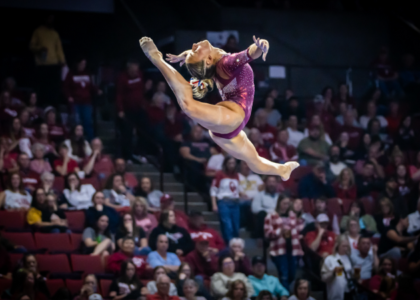Fantasy gym fans! Just in time for the start of the men’s season, we have good news: You can now play a men’s fantasy game! My Fantasy Gymnastics League (MyFGL) was created by three men’s gymnasts, William & Mary’s Connor Bowman, Ohio State’s Chris Cosma and William & Mary alumnus Jordan Kula.
We asked Bowman some questions via email. Answers have been edited for clarity and length.
College Gym News: When did you get the idea to start a men’s fantasy game? What did it take to build the site?
Connor Bowman: The idea of fantasy gymnastics has been floating around the gymnastics community for a long time. We know we were not the first group of gymnasts who wanted to play fantasy gymnastics by any means. We heard of people running a fantasy league using Excel sheets, manually inputting every score each week. As computer science students, we thought we could create a web-scraper that could automatically download all the scores to use for this type of fantasy gymnastics. The idea was to make fantasy gymnastics inside these spreadsheets much easier.
Once that was done, we decided to take a shot at creating an actual website. We took our first attempt at creating a fantasy website during our winter break in 2021. We created the website frontend and backend, designed the database models, and populated the database all from scratch. Fast forward two years later, we recently launched for the first time before the 2023 NCAA season started. Our project is still in development mode, though, as two of our lead developers are still in college.
CGN: What deadlines should players know about? What is the deadline for each league to finish its draft?
CB: Users can create new leagues and finish their draft at any point throughout the season. MyFGL does not have a deadline to create your league or draft with your friends.
However, we recommend doing so as early as possible to have as much playtime as possible!
CGN: It seems like league commissioners set team size, lineup size and event count; do you have any recommendations for commissioners for setting those numbers?
CB: Yes, the league manager sets the roster limit, lineup size and lineup count. We recommend a 15-gymnast roster limit with a five-gymnast lineup size and three-gymnast lineup count. NCAA men’s gymnastics has a 15-gymnast roster limit for competitions, so we recommend users mirror that. Using the five-up three-count settings gives users some flexibility in their lineups. Unfortunately, we do not know which gymnasts will be competing each week, but by having a weekly three-gymnast lineup count, matchups will be more exciting, and users will count fewer zeros toward their team score every week.
CGN: What is the weekly timeline? When each week can players add available gymnasts to their roster, and when are the week’s lineups due?
CB: Users can add and drop gymnasts from their roster at any point throughout the week. Users can add and remove gymnasts from any of their lineups until the start of that gymnast’s first meet for that week. For example, if Brody Malone competes on Friday at 6 p.m. ET, users that have him on their roster will be able to add him to their lineup until 6 p.m. ET. Once the meet officially starts, gymnasts competing will not be able to be added or removed from lineups.
CGN: Your game is based on head-to-head wins and losses, rather than overall team score. What led you to make this choice?
CB: We followed the fantasy football gameplay model. Our game is based on weekly head-to-head matchups. Once a league completes its draft, weekly matchups will be automatically created for the entire season. Each week every user will compete in a head-to-head matchup against another user in the league. The user in each matchup with the highest team score that week will win their respective matchup. At the end of each week, users’ records will be updated to reflect if they won, lost, or tied their matchup. At the end of the regular season, the team with the best record wins the regular season in the league. An example of a winning record is 6-2-0. This reflects a team that won six matchups, lost two, and tied zero.
During day one of the NCAA national championships, we have championship matchups. The top half of users with the best records will compete in a championship matchup. The bottom half of users with the worst records will compete in the loser’s championship matchup. These two matchups use scores from day one of the NCAA national championships. The final order from these matchups determine which user becomes the MyFGL Fantasy National Champion for the league.
CGN: How do you hope to see your game benefit men’s gymnastics?
CB: We hope that our platform gives gymnasts, fans, and parents a place to interactively stay invested in men’s gymnastics. We have plans to write articles throughout the season to help users stay updated on news around the NCAA and help them play fantasy gymnastics. We also plan to launch new game modes in the future. We hope by actively developing our games and platform so that we will be able to help grow the gymnastics community.
You can create your men’s fantasy team at MyFGL today!
READ THIS NEXT: A Q&A With GymChem, Creator of a New Fantasy Gymnastics Game for 2022
Article by Emily Minehart
Like what you see? Consider donating to support our efforts throughout the year!




